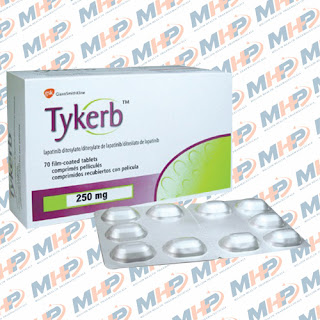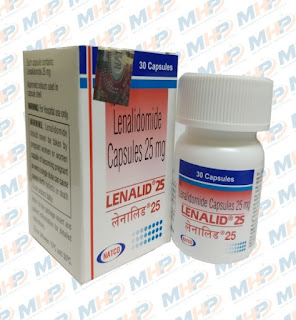TYKERB
DRUG PROFILE OF TYKERB
Tykerb tablets are categorized as anti-neoplastic agent, which is orally active drug used for treating breast cancer.
Tykerb tablets are comes under biological category which is targeted chemotherapy.
Tykerb tablets are classified as;
- Tyrosine kinase prohibitor
- Stop the HER2/neu & epidermal growth factor receptor activity
- Targeted therapy
- Signal transduction prohibitor
Tykerb 250mg tablets containing 250mg of Lapatinib as an active substance.
Tykerb is a synthetic oral tablet, chemically classified as quinazoline with strong anti-cancer effect.
Usually targeted therapy or tyrosine kinase inhibitor drugs are capable of increasing the serum amino transferase levels which may leads to liver injury.
 |
| TYKERB |
PRESCRIBING INFORMATION OF TYKERB
Tykerb consist of Lapatinib is primarily indicated for advanced breast cancer.
Tykerb is used in combination with;
Capecitabine with Tykerb tablets are usually indicated for the treatment of metastatic breast cancer patients in whose cancer cells expressed with EGFR 2 (HER2) and patients may already receive an anthracycline, taxane & Transtuzumab.
The major demerit of Tykerb:
Patients should be produce advancement of disease during Transtuzumab therapy, prior initiation of Tykerb with Capecitabine.
Tykerb tablet with letrozole is involved in the therapy of post menopausal women suffered with hormone receptor positive advanced breast cancer that contains HER 2 receptors.
Tykerb concurrent with Aromatase inhibitors have not been correlates to Transtuzumab chemotherapy drug for breast cancer therapy.
MECHANISM OF TYKERB
Chemically Lapatinib is categorized as 4-anilinoquinazoline derivative, which expels anti-cancer activity by prohibiting intracellular tyrosine kinase domains of EFGR & HER type 2.
The ErbB driven tumor cell production has been prohibited by Lapatinib.
This growth factor receptor present on cell surface of tumors which may leads to cause cell death.
Absorption
The absorption of Tykerb is incomplete and insufficient, the maximum plasma concentration time of Lapatinib occurs relatively 4 hours after drug intake.
The steady state reaches within 6 to 7 days
Distribution
Lapatinib is largely bounds to human plasma protein like albumin & alpha glycoprotein nearly 99%.
Metabolism
Lapatinib is a substrate of P-gp & BCRP and undergoes intensive metabolism by using CYPP3A4 & CYP3A5 with lesser contribution of CYP2C19 & CYP2C8.
Excretion
Tykerb in single dose reaches half life time in 14.2 hours and repeated dosing reaches in 24 hours.
Elimination occurs via feces & urine.
WHEN TO TAKE THE TYKERB
Tykerb tablets should be taken without food; administer 1 hour earlier or 2 hours after the food uptake.
Capecitabine should be administered with food or taken within 30 minutes after ingestion of food.
DOSAGE REGIMENS OF TYKERB
In HER2 positive advanced breast cancer:
The recommended dose of Tykerb is 1250mg should be administered orally as a single dose on day 1 to 21repeatedly combined with Capecitabine 2000mg/m2/day (should be taken orally in 2 doses relatively 12 hours apart) on day 1 to 14 in continuous 21 day cycle.
Totally 5 tablets of Tykerb should be taken at a time as whole.
In hormone receptor positive HER 2 positive advance breast cancer:
The prescribed dose is 1500mg should be administered orally as a single dose by combining with letrozole.
The prescribed dose of letrozole is 2.5mg as a once a day.
In these total 6 tablets of Tykerb should be administered as such.
Dose alteration:
Cardiac events:
In patients with reduction of left ventricular ejection fraction with grade 2, treatment with Tykerb should be discontinued.
In this condition, the dose of Tykerb should be initiated with 1000mg/day in combination with Capecitabine; whereas in combination with letrozole the dose of Tykerb restated with 1250mg/day after 2 weeks, if LVEF turns to normal.
Hepatic impairment:
For patient with severe hepatic impairment, the dose reduced from 1250mg/day to 750mg/day or from 1500mg/day to 1000mg/day.
Diarrhea:
Tykerb tablets should be restarted once the severity of diarrhea may reduced to grade I. permanently discontinued if diarrhea is persists.
Concurrent use of CYP3A4 inhibitors:
Tykerb should not be combined with CYP3A4 inhibitors; because of elevation of plasma concentration of Lapatinib occurs. For eradicate this effect, the dose of Tykerb should be reduced to 500mg/day.
Concurrent use of CYP3A4 inducers:
In this combinational study, the dose of Tykerb should be elevate from 1250mg/day to 4500mg/day or from 1500mg/day to 5500mg/day.
In other toxicity:
Postpone or stop the Tykerb therapy may happens, in case of developing higher grade of toxicities which is greater than or equal to grade II.
Tykerb use in combination with Capecitabine should be resume at lower doses 1000mg/day and whereas in combination with letrozole should be resume at lower dose of 1250mg/day.
TYKERB CAUSED SIDE EFFECTS
Diarrhea
Nausea
Vomiting
Stomatitis
Dyspepsia
Palmar plantar erythrodysaesthesia
Rash
Dry skin
Mucosal inflammation
Musculoskeletal pain in extremity
Back pain
Dyspnea
Insomnia
Elevation of hemoglobulin, platelets, neutrophils
Increase in AST & ALT, bilirubin
Alopecia
Pruritus
Nail disorders
Asthenia
Headache
Epistaxis
Reduction of left ventricular ejection fraction
Liver toxicity
Interstitial lung disease
Anaphylactic reactions
Stevens Johnson syndrome
Ventricular arrhythmias
QT prolongation
DRUG- DRUG INTERACTION
Tykerb tablets are inhibition of CYP3A4, CYP2C8 & P-gp drug transporters; weak inhibitor of CYP3A4.
The dose reduction of these concurrent uses of substrate drug should be advised, while allowing Tykerb combined with drugs metabolized by CYP3A4, CYP2C8 or P-gp.
Midazolam: use with Tykerb, increases the exposure of Midazolam
Paclitaxel: Increase in paclitaxel exposure occurs while concomitant with Tykerb
Digoxin: Serum digoxin concentration should be examined periodically before starting the concomitant use. If digoxin level in serum is greater than 1.2ng/ml, then the dose of digoxin reduced taken with half.
Drug that induce or inhibit CYP3A4 enzymes:
If Tykerb tablets should be combined with CYP3A4 inducers or inhibitors, dose alteration is necessary.
Ketaconazole with Tykerb, the dose reduced to 200mg as two times a day for 7 days.
Carbamazepine with Tykerb, the dose of carbamazepine at 100mg as a two times a day for 3 days & 200mg for two times a day for 17 days, the exposure of Tykerb reduced to 72%.
While combining Tykerb with P-gp inhibitors causes increasing the concentration of Lapatinib
Lapatinib solubility should be depends on pH values, increased pH reaches to decreased solubility.
Without regard to esomeprozole a proton pump inhibitor, taken as 40mg as a single dose for 7 days, did not result in significant reduction in Lapatinib steady state.
FOOD DRUG INTERACTION
Avoid uptake of grapefruit or juice that may increase the levels of Lapatinib contents in the body and causes various dangerous adverse effects.
Lapatinib should be taken on empty stomach, to prevent the delay in absorption.
POSSIBLE CONTRAINDICATIONS
A hypersensitivity reaction occurs in patients who are contraindicated to the component present in Tykerb tablet.
SAFETY MEASURES
Reduction in left ventricular ejection fraction:
Caution should be taken while using Tykerb in patient with LVEF
The virulence of LVEF should be decreased within first 12 weeks of treatment
Before starting the therapy with Tykerb, patient must be examining thoroughly if suspected with LVEF or not.
Liver damage:
Increasing level of AST, ALT or bilirubin may leads to liver injury
To prevent this condition, periodic LFT should be maintained
Diarrhea:
Severe diarrhea may leads to dehydration causes death also; if patient do not recover from this severity must discontinue with this therapy.
Interstitial lung disease:
Patient should be monitored with pulmonary symptoms and provide supportive measures.
On severe condition, treatment should be interrupt or discontinue
QT prolongation:
Monitor ECG periodically
Provide substituent for this adverse condition
Hypokalemia and hypomagnesemia correction should be takes place
Cutaneous reactions:
Some life threatening reactions may occurs, in this condition therapy should be stopped
Embryo fetal damage:
Tykerb causes fetal damage and produce some deformities.
Patient should advice, not getting pregnant during therapy.
PREGNANCY AND LACTATION
Pregnancy category: D
Tykerb should not be used in pregnancy condition
Breast feeding should not be allowed
The potency of Tykerb has not been evaluated in pediatric patients.
In both renal & hepatic impairment patients, caution should be taken while using this medication
STORAGE AND HANDLING
Tykerb carton should be kept at 25oC (77oF).
Keep the carton free from moisture, heat or light
MISSED DOSE
Missed dose should be skipped and follow the regular dosing schedule for avoiding adverse conditions. If missed dose occurs, it should not be resume and continue the next schedule.
OVER DOSAGE
The doses of Tykerb ranges from 2500mg to 9000mg daily, the duration of therapy should be varied between 1 & 17 days.
Symptoms occurred during over dose of Tykerb are;
Sore scalp, sinus tachycardia & mucosal inflammation
Tykerb is highly bound to human plasma protein; it is difficult to remove from the body and lesser extent in excretion through kidneys.
Patients should be providing with supportive measures.
Hemodialysis is not an effective method for overcoming the over dosage condition of Tykerb.
CONTACTS
Phone : +919940472902
USA Toll-Free Call : +18882264402
Email:millionhealthpharmaceuticals@gmail.com
WEBSITE: https://millionpharma.us/



Comments
Post a Comment